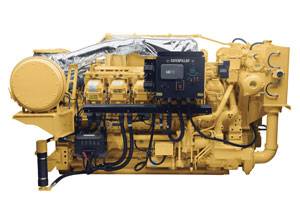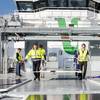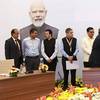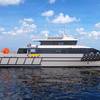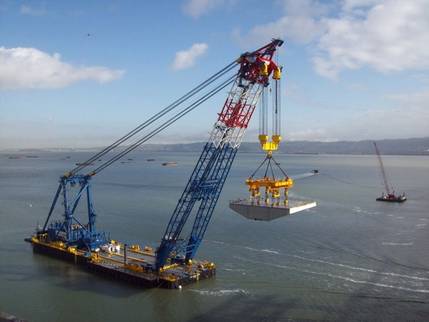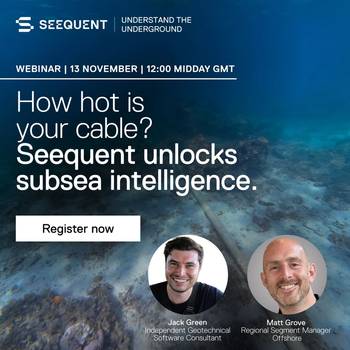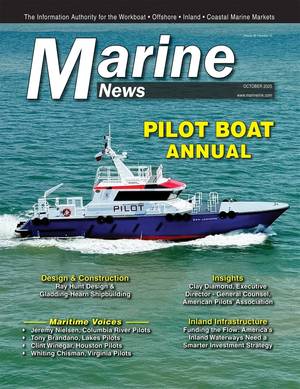Cat Marine Engines Re-Power US Army Dredge
The US Army Corps of Engineers operates two hopper dredges on the west coast of the U.S. to keep shipping channels open. The largest and most modern of them is the Essayons, built by Bath Iron works in Bath, Maine in 1982. Its aging power plant has been replaced by eight state-of-the-art Cat marine engines totaling more than 15,000 kW.
The 350 ft long Essayons is based in Portland, Oregon. Its annual schedule includes work in harbours between Alaska and California, as well as Hawaii. The crew routinely work on the edge of shipping channels while commercial ships pass nearby, and also close to jetties, reefs and wrecks, even in marginal weather, so both vessel and crew must be prepared for every eventuality.
Essayons was launched with four EMD 645 main engines (two for propulsion and two for dredge pumping) and three Cat D399 generator sets. In addition to its normal navigation equipment and hotel needs for a crew of 24, the ship needs 60 Hz power to run numerous valves, including those used for flushing and jetting in the hoppers and filling the ballast tanks.
After 25 years in service, the main engines were showing their age. They also did not meet the latest air-quality standards for California harbours. Consequently, the US Congress approved the funds to re-power the ship and install a new power-distribution system. The new line-up consists of eight Cat marine engines that meet EPA Tier 2 emission standards: 4x Cat C280-12 main engines, 3x Cat 3512C gen sets and 1x Cat C18 emergency gen set.
Ships’ engine rooms are rarely laid out to allow easy replacement of an entire engine. All the piping and wire runs in the forward engine room bulkhead had to be dismantled and an opening cut towards the hopper to prepare for the re-power. After the four old engines had been removed, the new Cat C280-12 engines, weighing a total 40 tons with generator attached, were craned into the hold and skidded into position. The Halton Company, the local Caterpillar dealer, provided consulting services for the installation.
The Cat C280-12 is a 222 litre, vee-type, 12 cylinder, medium-speed marine engine with electronic ADEM A3 control. It produces 3,460 kW at 900 rpm for continuous service and meets EPA Tier 2 emission standards. The dredge’s two outer C280-12 units are fitted with reduction gears turning controllable-pitch propellers that enable the engines to run at an efficient 750-950 rpm while the ship is dredging at only 1-2 knots. The two inner units are connected to Kato 600 V generators each producing 3,250 kW of electrical power.
The smaller Cat 3512C gen sets are placed in a separate engine room. They are also connected to Kato generators, each rated 1,030 kW at 1,800 rpm. The 3512C series uses electronic engine control as well to achieve high performance and low emissions. All three gen sets are set on flex mounts to reduce vibration and noise.
All five generators are controlled via an automated power management system. Engine functions, temperatures and pressures are monitored and displayed on ten computer work stations mounted in various locations on the bridge, the engine room and in the fire-fighting station.
The two Cat C280 gen sets supply power to the 600 volt bus, whereas the three Cat 3512C gen sets serve the 480 volt bus. The dredge pumps and the bow thruster run off the 600 volt bus. The dredging hydraulics and the rest of the ship’s electrical load run off the 480 volt bus.
Both busses are cross-connected via circuit breakers and a transformer, thus guaranteeing maximum flexibility in load sharing. For example, when dredging, the two C280 gen sets can supply power for all electrical loads on the ship at both 480 V and 600 V. If transiting, just two of the 3512C gen sets provide ample power for the bow thruster and all remaining loads.
The last of the eight engines on the Essayons is the emergency generator, located high above the waterline. This is a 6 cylinder Cat C18 developing 425 ekW at 1,800 rpm, which is sufficient to keep the lights running should the ship be damaged by some hazard. However, since there are seven other powerful Cat engines aboard this should never ever happen.
The re-powering project was managed by Cascade General at the Portland Shipyard in 2008.
“The new engines have greatly improved our operational efficiency,” said Captain James Holcroft, who has been in command of the Essayons for six years. “With the old engines, when dredging upstream and going against a strong current, we barely had enough power to maintain forward motion. With the new Caterpillar engines, we have an extra 2,000 hp enabling us to get the job done even under difficult conditions.”
Holcroft also emphasised the improvements achieved because of electronic engine control and performance monitoring. “We are able to spot potential problems at an early stage by checking engine data on the control displays. And by having 100 percent Cat power on board, we only need to stock one brand of spare parts.”



